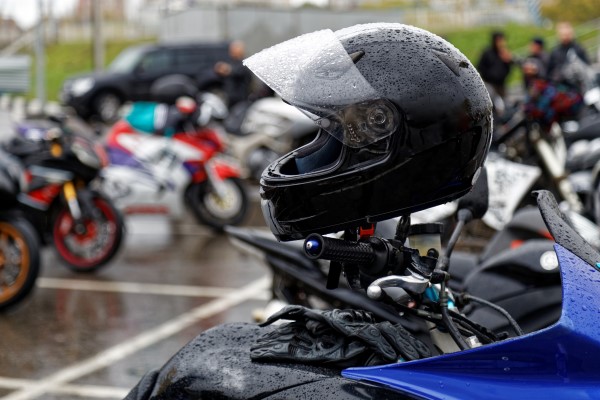Motorbike protective clothing and the PPE Directive
As an avid motorcyclist I speak from experience when I say, “if you do ride a motorcycle there is a reasonable chance you will fall at some point in your riding career.” The reasons why and the resulting outcomes of a fall will vary greatly but wearing the correct protective clothing may help to reduce potential injuries that follow.
 It became a legal requirement to wear a crash helmet in 1973 but it’s not compulsory to wear any other form of protective clothing whilst riding a motorcycle. However, there have been recent reports of personal injury payments being reduced due to riders who were involved in accidents not wearing appropriate protective clothing. It’s not yet known if this will become the norm or indeed force any law changes in the future.
It became a legal requirement to wear a crash helmet in 1973 but it’s not compulsory to wear any other form of protective clothing whilst riding a motorcycle. However, there have been recent reports of personal injury payments being reduced due to riders who were involved in accidents not wearing appropriate protective clothing. It’s not yet known if this will become the norm or indeed force any law changes in the future.
Interestingly, unlike a cycling helmet, a crash helmet is not regarded as personal protective equipment (PPE) and does not fall under the PPE Directive or future Regulation. Also with greater awareness of hearing damage from wind noise, many riders now wear ear plugs but whilst these plugs fall under the PPE directive they are not specific to motorcycling so for these reasons I will not discuss either of these items in this blog.
 The main outer suit is subject to the EN 13595 (1-4) series of standards but these only apply to jackets, trousers, once piece or divided suits worn by professional riders excluding those involved with motorsport competition events organised by Federation. Leathers and suits worn by recreational riders are not currently required to comply with this standard.
The main outer suit is subject to the EN 13595 (1-4) series of standards but these only apply to jackets, trousers, once piece or divided suits worn by professional riders excluding those involved with motorsport competition events organised by Federation. Leathers and suits worn by recreational riders are not currently required to comply with this standard.
However, the body armour within a suit or intended to be incorporated into a riders clothing (leather or fabric) is subject to the EN 1621 (1-4) range of standards. As a recreational rider my leathers are not certified to EN 13595 but the back protector and shoulder/joint protection within them have EN 1621-1:2012 and EN 1621-2:2014 respectively. There is no distinction between on and off road activities.
Other forms of body protection that could be worn by a rider are Chest Protectors which is covered by EN 1621-3 (currently under construction) and is for devices designed to protect the chest from mechanical impacts whilst the Inflatable Protector (air bag) covered by EN 1621-4:2013, which is currently not harmonised and may be subject to further review in the future.
Inflatable protectors currently come in two forms, either as a life jacket type of device that you wear over your clothing or some that are incorporated into your clothing and are not visible. Activation occurs with from a strap that is attached to the motorcycle, in an accident the strap is pulled tight and activates the inflation. Other systems use sensors to determine whether an accident is occurring and activate accordingly.
Stone shields covered by EN 14021:2003 are products that are solely designed to protect an off road riders torso from stones and small debris that have been kicked up by the tyres, either from their own motorcycle or from one that they are following. A stone shield may not protect against the same mechanical impacts a chest protector may provide so there is a differentiation between the two.
 To help protect the extremities protective gloves and boots are advised. Protective gloves are covered by EN 13594:2015 and this standard now applies to all motorcycle on-road uses whereas in the 2002 edition it applied to professional riders only. Boots are covered by EN 13634:2015 and apply to boots used for on or off road activities.
To help protect the extremities protective gloves and boots are advised. Protective gloves are covered by EN 13594:2015 and this standard now applies to all motorcycle on-road uses whereas in the 2002 edition it applied to professional riders only. Boots are covered by EN 13634:2015 and apply to boots used for on or off road activities.
Many of these standards for body armour, boots and gloves refer to two levels of protection; a lower level of protection that does not affect the ergonomics of the article, allowing riders good movement, and a higher level of protection that does affect the ergonomics as a compromise of added protection. However, anything that is considered too stiff or too heavy is not acceptable and each standard should be referred to more closely for the definitive explanation.
 The basic design for motorcycle protective clothing has not really changed over the past 90 years; head and eye protection, gloves, boots and a tough outer suit which was usually made of leather but with the progress of textiles and fabrics non-leather materials are now used as well.
The basic design for motorcycle protective clothing has not really changed over the past 90 years; head and eye protection, gloves, boots and a tough outer suit which was usually made of leather but with the progress of textiles and fabrics non-leather materials are now used as well.
With the introduction of the new PPE Regulation we may see some articles of PPE becoming obsolete, if they cannot meet the requirements of the more recent standards.
Find out more about the PPE Regulation
Author: David Tuplin
Certification Manager – PPE, BSI



